Open source and free shadcn templates using Tailwind
188 templates • 159 contributors • Open source & free
188
Templates
159
Authors
Available Templates (188)

Next Ecommerce Shopco
Shopco is a fully functional, open-source e-commerce website that converts a professional Figma design into a responsive, production-ready web application using Next.js 14 App Router, TypeScript, Tailwind CSS, shadcn/ui components, Framer Motion for animations, and Redux Toolkit for state management. This project demonstrates best practices for building modern e-commerce platforms with server-side rendering, static site generation, smooth animations, and global state management while maintaining excellent performance and SEO optimization. The application features a complete product catalog with filtering, sorting, and search functionality, responsive, mobile-first design that works beautifully across all devices, shopping cart management powered by Redux Toolkit, smooth page transitions and micro-interactions using Framer Motion, accessible and customizable UI components from shadcn/ui, optimized images and fonts for fast loading times, type-safe development with TypeScript throughout, and well-organized project structure following Next.js 14 best practices. The tech stack showcases how to combine Redux for complex state management with Next.js server components, implement animations that enhance rather than hinder user experience, structure large applications with clear separation of concerns in app routing, components, Redux features, and styles, and build SEO-friendly e-commerce sites with proper meta tags and semantic HTML. This project is valuable for developers learning to build production-ready e-commerce applications from design to deployment, studying how to convert Figma designs into pixel-perfect web implementations, understanding Redux Toolkit patterns in modern Next.js applications, exploring animation best practices with Framer Motion, and creating portfolio pieces demonstrating full-stack e-commerce capabilities. Released under the MIT License, Shopco serves as both a functional e-commerce template and an educational resource for contemporary web development practices in the e-commerce domain.
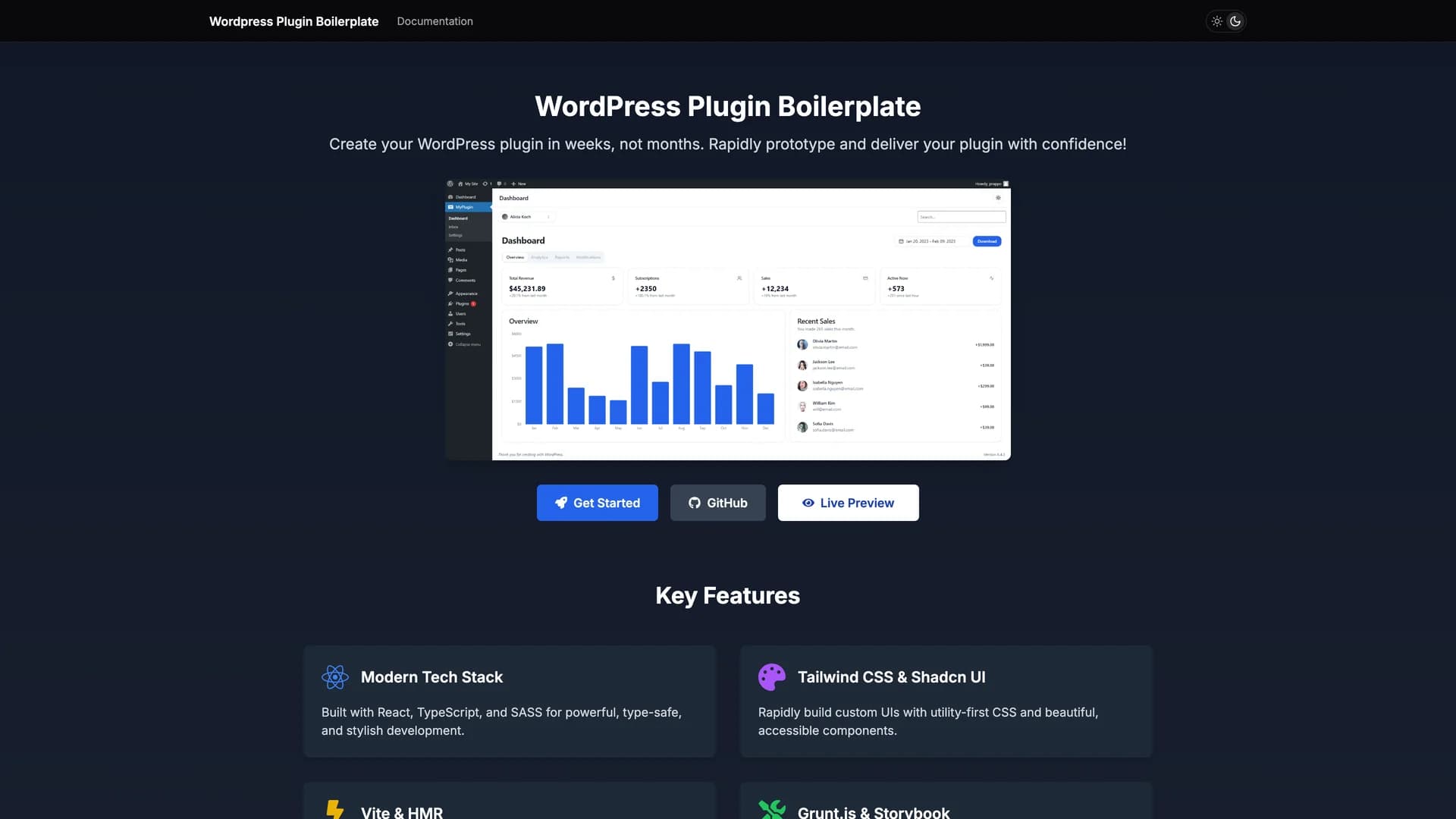
WordPress Plugin Boilerplate
The WordPress Plugin Boilerplate is a comprehensive starter template that brings modern web development practices to WordPress plugin development by integrating React, TypeScript, SASS, Tailwind CSS, shadcn/ui components, Vite for blazing-fast builds, Storybook for component development, and Hot Module Replacement for instant feedback during development. This boilerplate eliminates the traditional pain points of WordPress plugin development by providing a Laravel-inspired custom ORM for database operations, flexible API routing for REST endpoints, simplified shortcode generation with custom rendering, seamless data passing between PHP backend and React frontend, and a CLI tool for rapid plugin scaffolding and configuration. The development workflow is streamlined with npm run dev for full development mode with HMR, separate npm run dev:frontend and npm run dev:admin commands for focused development, npm run build to compile production-ready assets, and npm run release to create distributable plugin packages. The boilerplate includes Storybook integration for isolated component development and documentation, TypeScript for type safety across JavaScript code, SASS and Tailwind CSS for flexible styling options, shadcn/ui and Headless UI for accessible component primitives, and proper WordPress hooks and filters integration maintaining compatibility with the WordPress ecosystem. This template is invaluable for developers building commercial WordPress plugins with modern UIs and complex functionality, agencies developing multiple client plugins who need consistent, maintainable architecture, teams transitioning from jQuery-based WordPress development to React, freelancers who want professional development experience in WordPress projects, and anyone frustrated with traditional WordPress plugin development workflows. The project demonstrates how to integrate modern JavaScript frameworks into WordPress without fighting the platform, structure plugin code for maintainability and testability, implement database models and API routes in WordPress context, build component libraries with Storybook for WordPress admin interfaces, and accelerate WordPress plugin development with contemporary tooling.
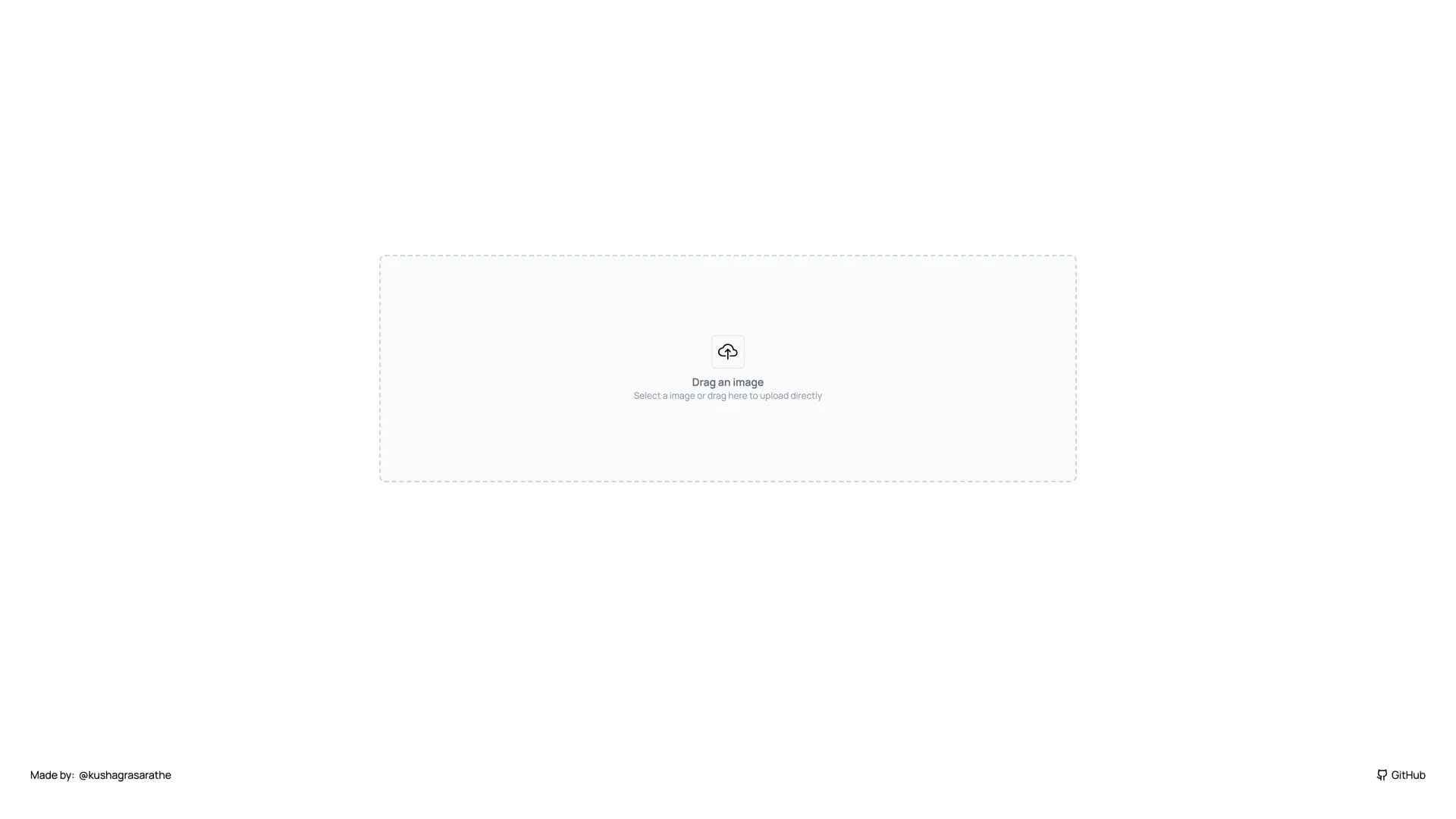
Image Upload Shadcn
Image Upload shadcn is a clean, reusable image upload component built with Next.js, TypeScript, shadcn/ui components, and Cloudinary integration for cloud-based image storage and management. This implementation demonstrates best practices for handling file uploads in modern React applications, including drag-and-drop functionality, image preview, upload progress feedback, and seamless integration with Cloudinary's powerful image CDN and transformation API. The component features intuitive drag-and-drop interface for effortless image selection, instant image preview before upload confirmation, responsive UI built with shadcn/ui components ensuring consistent styling, Cloudinary integration for scalable, cloud-based image storage, TypeScript throughout for type safety and better developer experience, optimized image delivery through Cloudinary's global CDN, and easy deployment on Vercel for production-ready hosting. Unlike basic file upload inputs, this component provides a polished user experience with visual feedback, error handling, and professional styling that matches shadcn/ui's design language. The Cloudinary integration eliminates the need for custom server-side upload handling, providing automatic image optimization, transformation capabilities, and reliable storage without managing your own infrastructure. This component is perfect for building user profile picture uploads in social applications, product image management in e-commerce platforms, document or receipt uploads in business applications, media galleries requiring cloud storage and CDN delivery, and any form requiring image input with professional UX. The project demonstrates how to implement file uploads in Next.js applications, integrate third-party services like Cloudinary with proper environment configuration, create reusable upload components with shadcn/ui, handle user feedback during asynchronous operations, and deploy image-heavy applications on Vercel. The TypeScript implementation ensures type safety when working with file objects and Cloudinary responses.
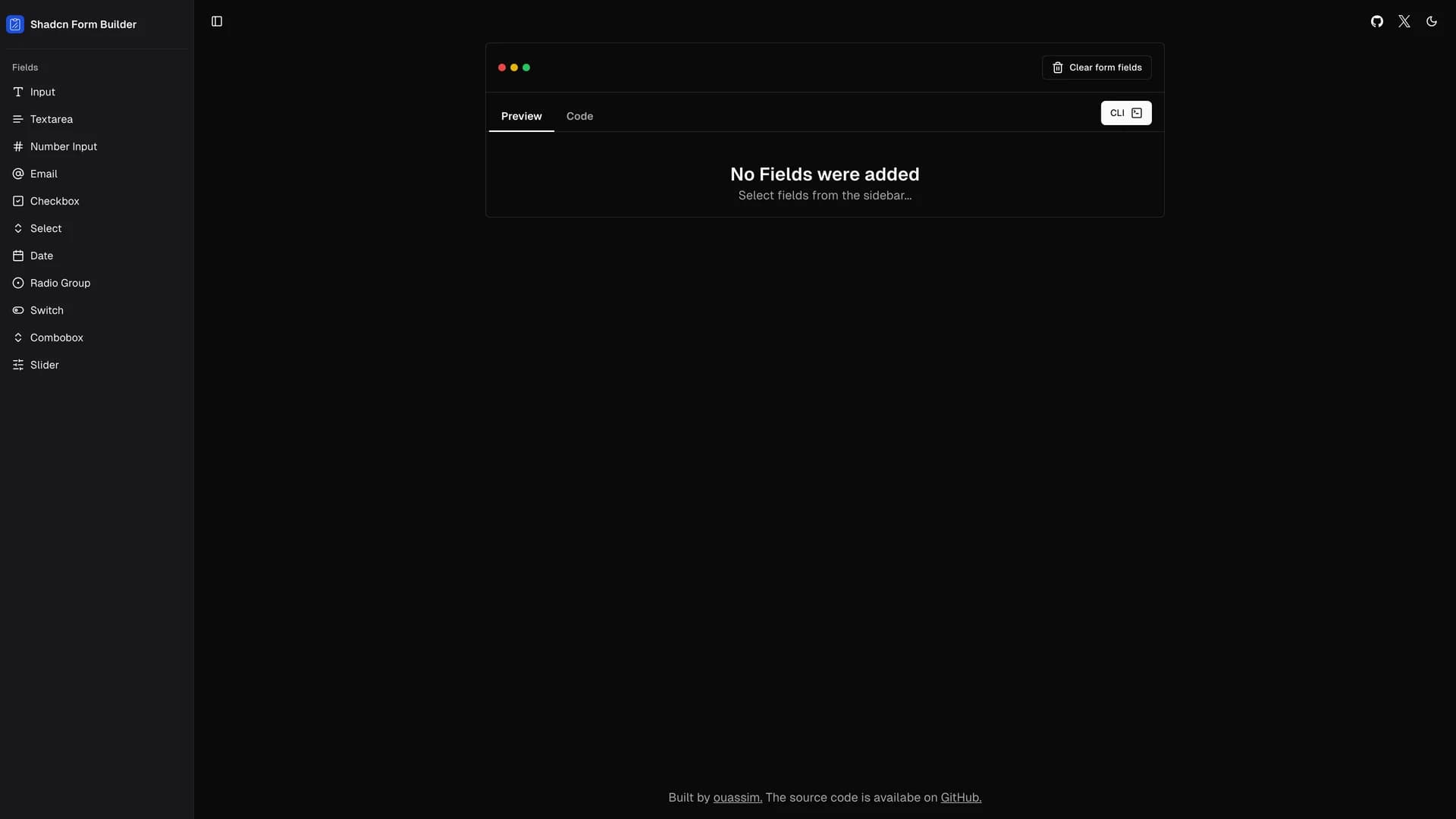
Shadcn UI Form Builder
The shadcn/ui Form Builder is a powerful WYSIWYG (What You See Is What You Get) form generation tool that revolutionizes form development by allowing developers to visually select input fields and automatically generate production-ready code with integrated shadcn/ui components, React Hook Form, and Zod validation schemas. Built with Next.js, TypeScript, Tailwind CSS, Drizzle ORM for database management, and shadcn/ui components, this tool eliminates the tedious manual work of writing form boilerplate, validation schemas, and component wiring. The form builder features a visual drag-and-drop interface for selecting and configuring input fields, automatic Zod schema generation ensuring type-safe validation, seamless integration with React Hook Form for performant form state management, one-click code generation producing copy-paste ready form components, support for various input types including text, email, number, select, checkbox, radio, and more, multi-field line configurations for complex form layouts, and customizable styling following shadcn/ui's design patterns. The platform's philosophy is simple: imagine selecting the input fields you need and having everything else—validation, state management, error handling, accessibility—done automatically. The ambitious roadmap includes expanding input field types with file uploads, OTP inputs, and multi-select components, support for alternative validation libraries beyond Zod, and pre-built form templates for common use cases like contact forms, registration forms, and surveys. This tool is invaluable for developers building forms who want to skip repetitive boilerplate and focus on unique logic, teams establishing consistent form patterns across multiple projects, rapid prototyping scenarios where form creation speed matters, applications requiring numerous forms with different field configurations, and anyone frustrated with manually wiring React Hook Form and Zod together. The Form Builder demonstrates how to create developer productivity tools, implement code generation with proper formatting and imports, integrate form libraries for optimal developer experience, and design intuitive interfaces for technical tasks.
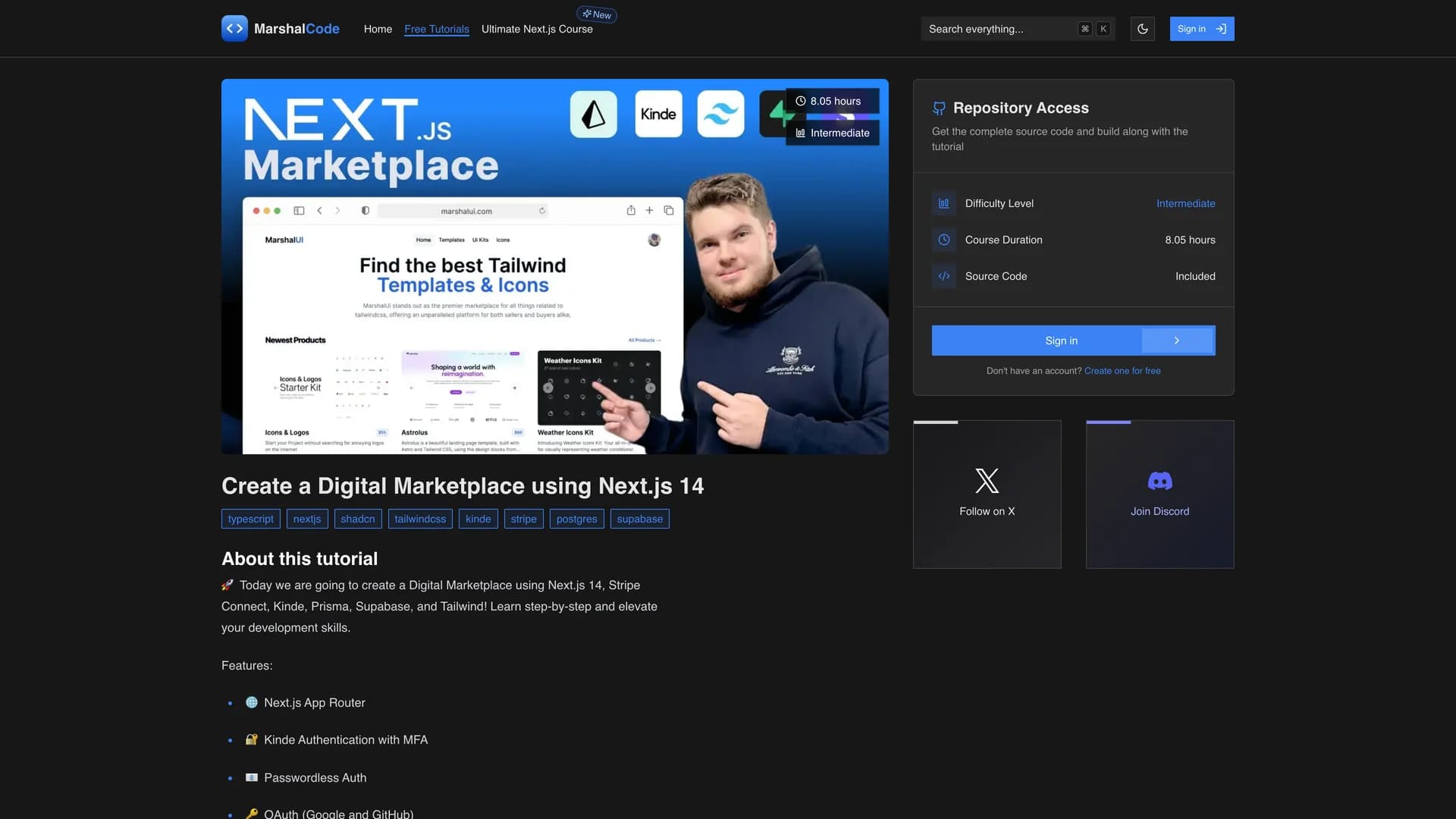
Marshal UI YouTube
Marshal UI is a comprehensive digital marketplace application built with Next.js 14, demonstrating how to create production-ready platforms where creators can sell digital products with built-in payment processing, authentication, and database management. Created by Jan Marshal as a step-by-step tutorial project, this full-featured marketplace integrates Kinde for robust authentication including multi-factor authentication and passwordless login, Stripe Connect for marketplace payments enabling seller payouts and platform fees, Prisma ORM with Supabase PostgreSQL for type-safe database operations, Tailwind CSS and shadcn/ui for modern, accessible components, Zod for server-side validation ensuring data integrity, Resend and React Email for transactional email templates, and deployment on Vercel for global edge performance. The application features comprehensive authentication flows supporting OAuth with Google and GitHub, passwordless magic link login, multi-factor authentication for enhanced security, seller onboarding with Stripe Connect allowing creators to receive payments, product listing and management for digital goods, secure payment processing with Stripe webhooks for real-time updates, email notifications using beautifully designed React Email templates, and server-side validation protecting against malicious inputs. The marketplace architecture showcases how to handle complex payment flows where platform fees are collected while sellers receive payouts, implement webhook handling for asynchronous Stripe events, design database schemas for multi-sided marketplaces, and build type-safe APIs with proper error handling. This project is invaluable for developers learning to build marketplace platforms like Gumroad or Etsy, understanding Stripe Connect integration for multi-vendor payment processing, implementing modern authentication patterns with Kinde, studying full-stack Next.js 14 application architecture, and creating portfolio projects demonstrating e-commerce expertise. The tutorial format helps developers elevate their skills by walking through real-world challenges in marketplace development.
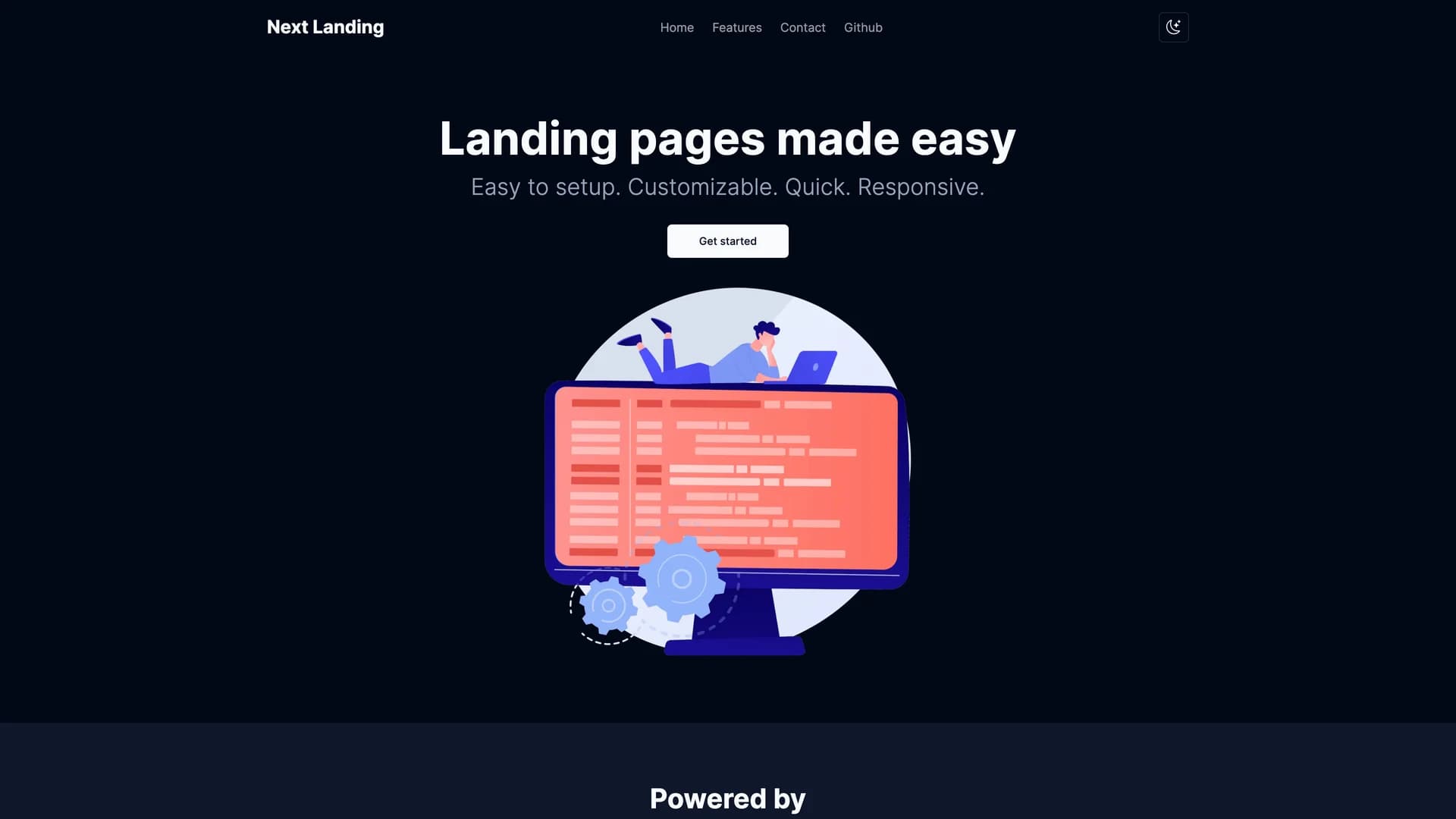
Next Shadcn Landing
Next Shadcn Landing is a streamlined, production-ready landing page template built with Next.js, shadcn/ui, TypeScript, and Tailwind CSS that's designed to be easy to set up, highly customizable, quick to deploy, and fully responsive across all devices. Unlike complex landing page builders or bloated templates, this starter focuses on simplicity and developer experience, allowing you to launch professional landing pages in minutes rather than hours. The template features a clean, modern design following shadcn/ui's aesthetic principles, fully responsive layout adapting seamlessly to mobile, tablet, and desktop screens, TypeScript support ensuring type safety throughout the codebase, Tailwind CSS for rapid styling customization, organized project structure with clear separation of concerns, and simple configuration through centralized config files. Customization is straightforward: modify content in the /config folder for site-wide settings, adjust layouts and routing in the /app directory, change navigation links in lib/links.ts, and deploy to Vercel with a single click. The setup process takes minutes: clone the repository using degit, update package.json with your project name, install dependencies with your preferred package manager, and run the development server to see your landing page. This template is perfect for indie developers launching SaaS products who need professional landing pages quickly, startups building MVPs who want to focus on product rather than marketing site development, agencies creating client landing pages with consistent, maintainable architecture, developers building portfolios or personal sites with modern web technologies, and anyone who values simplicity and speed over feature bloat. The minimalist approach means less code to maintain, faster page loads, and easier customization compared to heavyweight landing page frameworks. Released under the MIT License, Next Shadcn Landing provides the essential foundation for landing pages without unnecessary complexity, letting you customize what matters while handling the boilerplate.
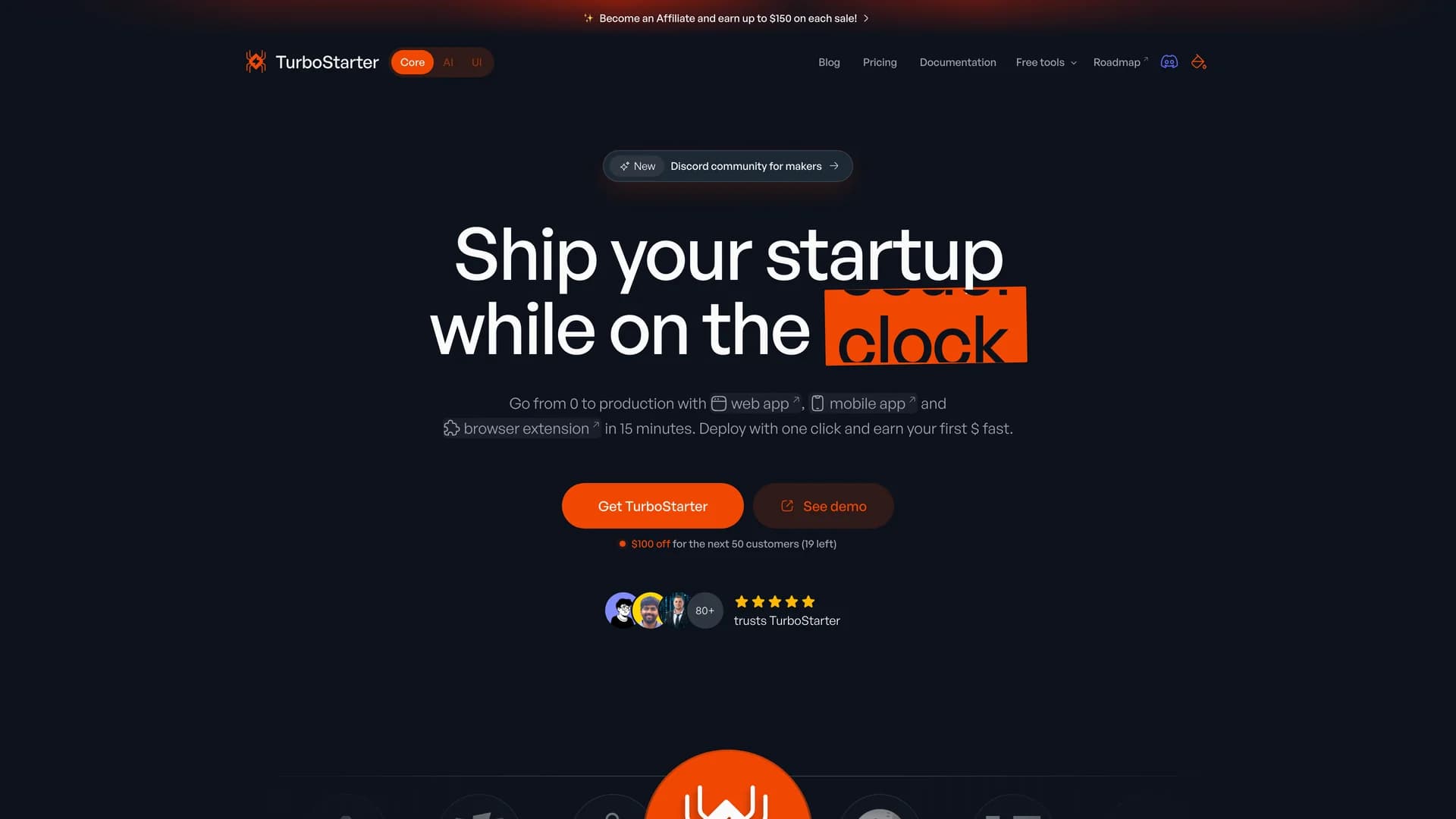
Turbostarter Extro
Extro is an opinionated, open-source browser extension starter kit based on learnings from building multiple production extensions, providing a comprehensive foundation with React, WXT framework, Supabase backend, shadcn/ui components, TypeScript, Tailwind CSS, Bun package manager, Vite for frontend tooling, and Biome for linting and formatting. Created by Bartosz Zagrodzki, this starter kit eliminates months of configuration by providing battle-tested patterns for authentication, storage, messaging, and deployment across Chrome and Firefox browsers. The template features full TypeScript type safety across extension pages and backend services, support for all extension page types including popup, options, background workers, content scripts, and side panels, authentication and OAuth integration powered by Supabase, storage and messaging APIs for cross-context communication, hot module replacement for instant feedback during development, pre-configured CI/CD pipelines for automated testing and deployment, internationalization (i18n) support for multi-language extensions, analytics integration for tracking user behavior, and modern development tooling with Biome for fast linting and formatting. Unlike starting from scratch with browser extension APIs, Extro provides proven patterns for handling complex scenarios like cross-origin messaging, persistent storage across extension contexts, authentication flows within extension constraints, and building multiple extension pages that share code efficiently. This starter is invaluable for developers building productivity extensions who want to focus on features rather than boilerplate, indie developers launching browser extensions as products, teams creating internal tools as browser extensions, developers migrating from Manifest V2 to V3, and anyone frustrated with the complexity of browser extension development. The opinionated stack means less decision fatigue while maintaining the flexibility to customize for specific needs. Extro demonstrates how to architect modern browser extensions with proper separation of concerns, integrate backend services with extension frontends, implement authentication within extension security constraints, and deploy extensions to both Chrome Web Store and Firefox Add-ons.
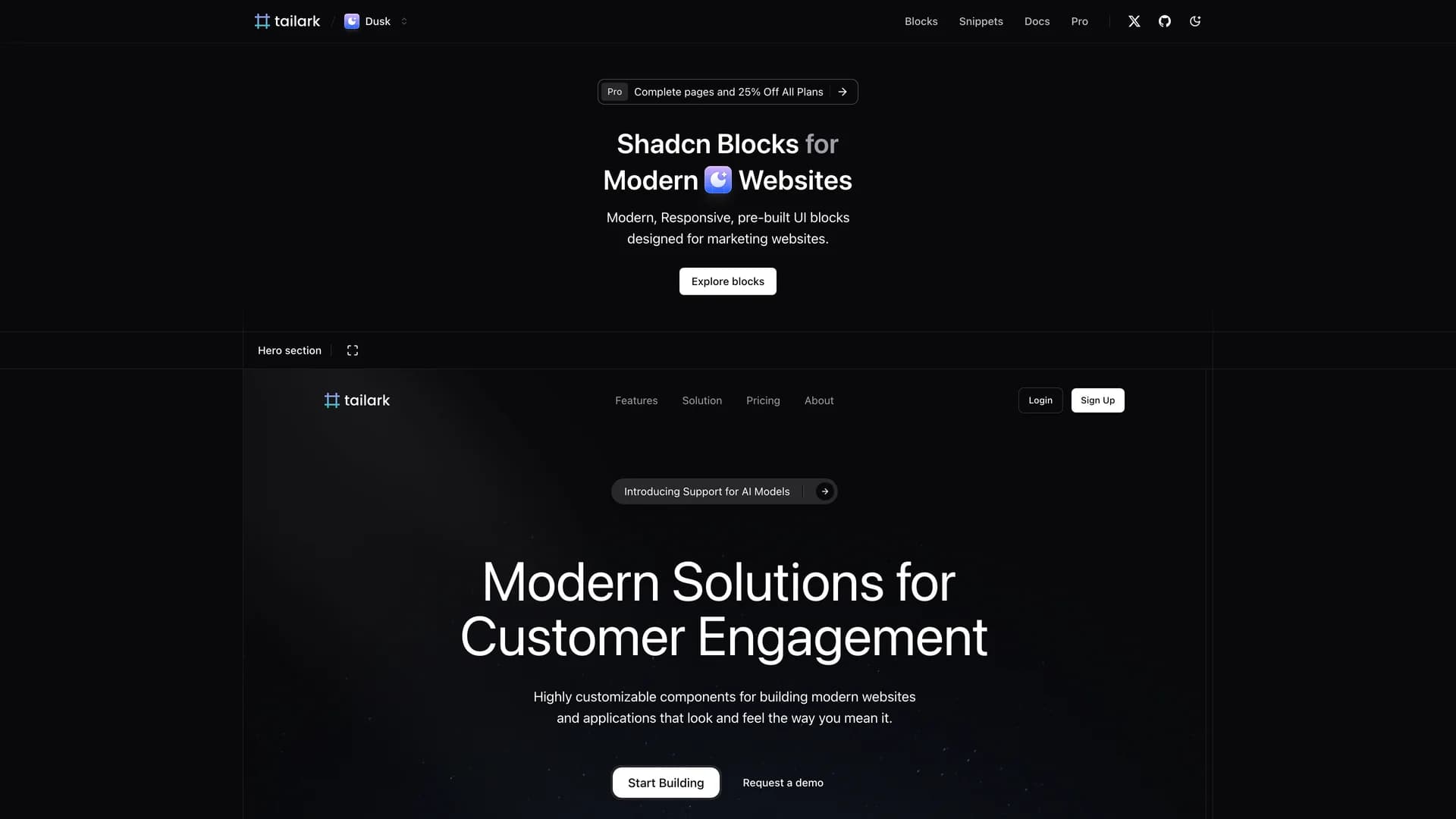
CNBlocks
CNBlocks (also known as Tailark blocks) is a collection of pre-built, responsive marketing website sections designed to speed up workflow by providing copy-paste shadcn/ui and Tailwind CSS blocks specifically optimized for marketing pages. Built with Next.js, TypeScript, Tailwind CSS, and shadcn/ui components in a monorepo structure managed by pnpm workspace and Turbo, this library offers developers ready-to-use sections that can be dropped into marketing sites without starting from scratch. The blocks feature fully responsive designs that adapt to mobile, tablet, and desktop screens, pre-styled shadcn/ui components maintaining consistent design language, Tailwind CSS classes for easy customization, TypeScript throughout ensuring type safety, modular architecture allowing selective usage of only needed blocks, and modern monorepo structure demonstrating professional project organization. Unlike generic component libraries, these blocks are purpose-built for marketing website patterns including hero sections, feature showcases, pricing tables, testimonials, call-to-action sections, and footer layouts, providing context-specific designs rather than isolated components. The collection eliminates the repetitive work of building common marketing page sections, allowing developers to assemble professional marketing sites by combining pre-tested blocks and customizing them for specific branding. This resource is perfect for developers building SaaS landing pages who need professional marketing sections quickly, agencies creating client websites with consistent, high-quality designs, startups launching products who want marketing pages without hiring designers, indie developers building side projects on tight timelines, and anyone who values speed and consistency over building every section from scratch. The project demonstrates how to organize component libraries as monorepos, create reusable marketing sections with shadcn/ui, structure blocks for easy copy-paste integration, and build maintainable component collections with TypeScript and Tailwind CSS.
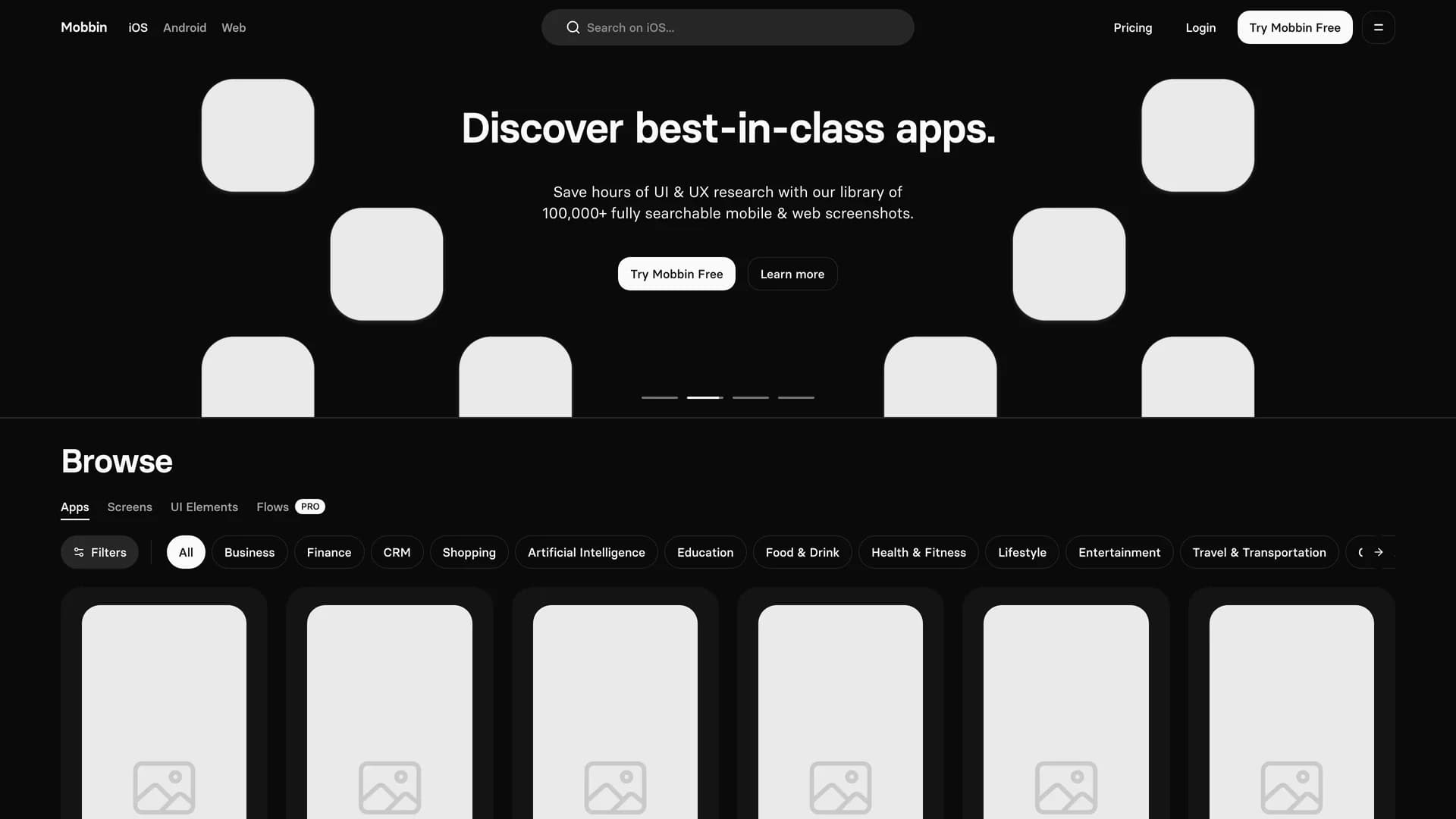
Next Mobbin Clone
The Next Mobbin Clone is a UI-focused project that replicates Mobbin.com's design to test and showcase shadcn/ui's latest components including Carousel, CommandDialog, Dropdown Menu, HoverCard, and Checkbox in a real-world interface context. Built with Next.js 14, shadcn/ui, Tailwind CSS, and Framer Motion for animations, this #builtinpublic project demonstrates how shadcn/ui components work together to create sophisticated, production-quality interfaces while serving as a learning resource for developers exploring component composition patterns. Created by @miickasmt in 2024, the clone focuses purely on UI implementation without backend functionality, showcasing pixel-perfect icon design, performance optimization using next/font for font loading, dynamic Open Graph image generation for social sharing, and smooth animations enhancing user interactions. The project demonstrates shadcn/ui's Carousel component for image and content sliders, CommandDialog for keyboard-first navigation and search, Dropdown Menu for contextual actions and settings, HoverCard for rich preview experiences on hover, and Checkbox for selection and filtering interfaces. Unlike simple component demos that show components in isolation, this clone places them in a cohesive, real-world UI where interactions between components feel natural and purposeful. The roadmap includes fixing UI interactions for improved polish, adding authentication pages to expand component coverage, and implementing a pricing page demonstrating shadcn/ui in conversion-focused contexts. This project is invaluable for developers learning how to compose shadcn/ui components into complete interfaces, studying real-world component interaction patterns, understanding Next.js 14 performance optimization techniques, exploring Framer Motion integration with shadcn/ui, and building portfolio pieces demonstrating frontend craftsmanship. The UI-only approach keeps the codebase focused and accessible, making it easy to extract patterns and adapt them for your own projects. Released under MIT License, the Mobbin clone serves as both a reference implementation and inspiration for building polished web interfaces.
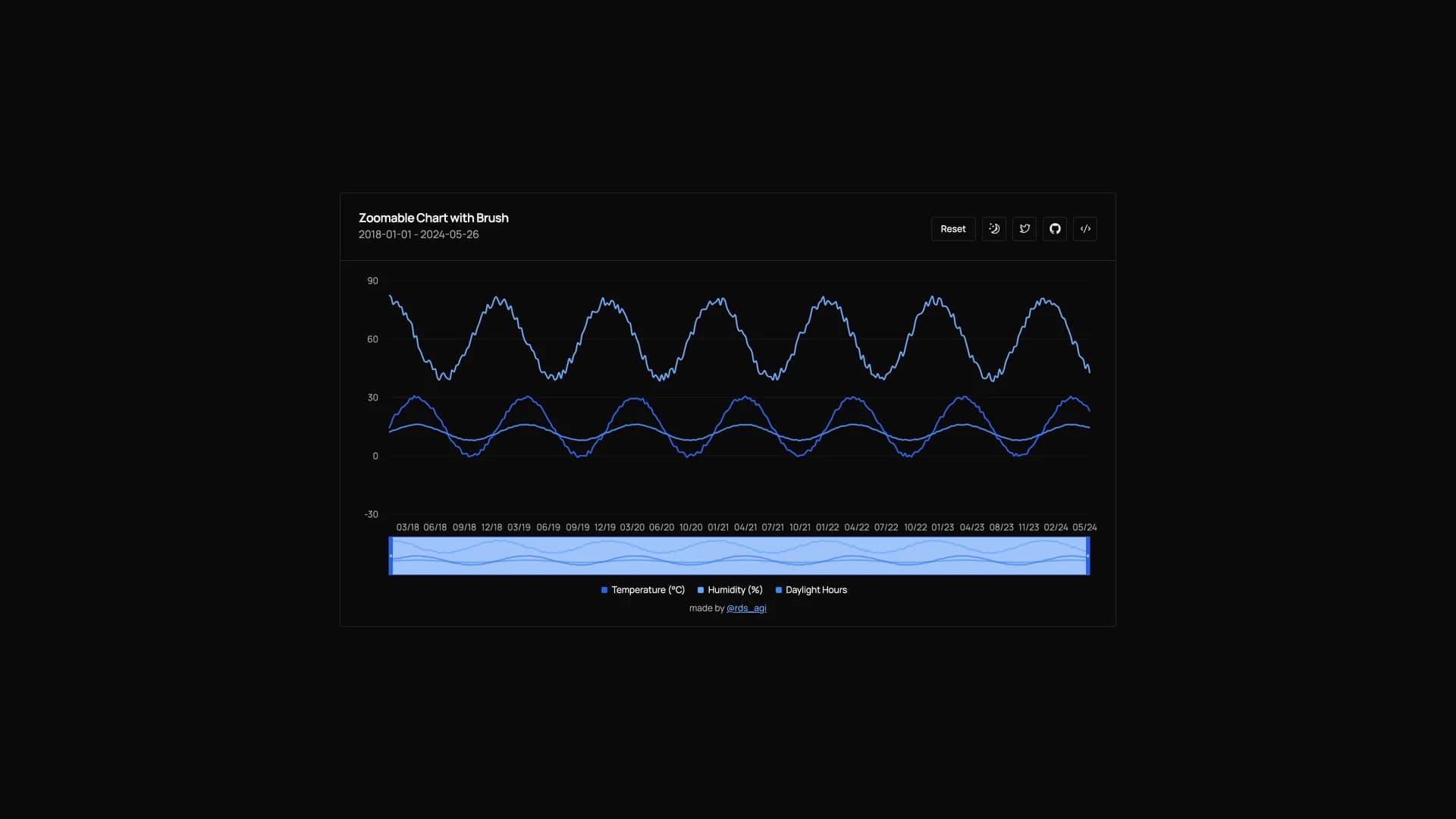
Shadcn Chart Brush
The shadcn Chart Brush is an interactive, zoomable chart component built with shadcn/ui's charting system and Recharts, providing multiple intuitive zoom and pan methods including click-and-drag zoom, scroll wheel zooming, and brush tool for precise navigation through large datasets. Built with Next.js, React, TypeScript, and Tailwind CSS, this component solves the common challenge of visualizing and exploring large time-series or numerical datasets where users need to focus on specific data ranges without losing context of the overall dataset. The implementation features click-and-drag interaction allowing users to select specific regions to zoom into, scroll wheel zoom for quick magnification adjustments similar to Google Maps, brush tool providing a minimap-style overview with a draggable selection area for zooming and panning, reset button to restore the original view and zoom level, and smooth transitions making zoom and pan operations feel natural and responsive. Unlike basic chart implementations that show all data without interaction or provide only limited zoom controls, this component combines multiple zoom methods giving users flexibility to explore data in whatever way feels most intuitive for their task. The brush component is particularly powerful for datasets with thousands of points where seeing everything at once obscures meaningful patterns but zooming helps identify trends, anomalies, or specific events. This chart is perfect for building financial dashboards where analysts need to examine price movements across different timescales, analytics platforms displaying website traffic or user behavior over time, scientific applications visualizing experimental data with precise region selection, monitoring tools showing system metrics or logs where zooming helps identify issues, and any data visualization requiring detailed exploration of specific ranges while maintaining context. The project demonstrates how to implement advanced chart interactions with Recharts, create intuitive zoom and pan controls, build responsive data visualizations with shadcn/ui, and design user-friendly interfaces for data exploration.

Linkify
Linkify is an innovative link management SaaS platform featuring a modern, conversion-optimized landing page that showcases link shortening, analytics dashboards, customizable branded links, and AI-powered suggestions for link optimization. Built with Next.js, Tailwind CSS, Prisma ORM, MongoDB for flexible data storage, Clerk for authentication, and a combination of premium UI libraries including shadcn/ui, Magic UI, and Aceternity UI, this template demonstrates how to create visually stunning SaaS landing pages that convert visitors into customers. The platform features comprehensive link tracking and analytics showing click-through rates, geographic data, and referral sources, customizable branded short links allowing businesses to maintain brand consistency, AI-powered optimization suggestions improving link performance through intelligent recommendations, responsive landing page design that works beautifully across all devices, modern UI patterns using glassmorphism, gradients, and micro-interactions, clean interface focused on user experience and conversion optimization, and integration patterns for authentication, database, and analytics services. Unlike generic landing page templates that look dated or prioritize aesthetics over conversion, Linkify balances beautiful design with clear value propositions, strong calls-to-action, and social proof elements that drive user acquisition. The multi-library UI approach combines shadcn/ui's accessible components with Magic UI's animated elements and Aceternity UI's distinctive design patterns, creating a unique visual identity that stands out in crowded SaaS markets. This template is invaluable for entrepreneurs launching link management or URL shortening SaaS products, developers building portfolio pieces demonstrating modern SaaS development, teams creating landing pages for beta launches or product announcements, designers learning how to implement complex UI patterns in code, and anyone studying conversion-focused SaaS landing page design. The project includes a YouTube tutorial explaining implementation details, making it accessible for developers at various skill levels. Released under MIT License, Linkify serves as both a functional SaaS landing page template and an educational resource for building modern, conversion-optimized marketing sites.
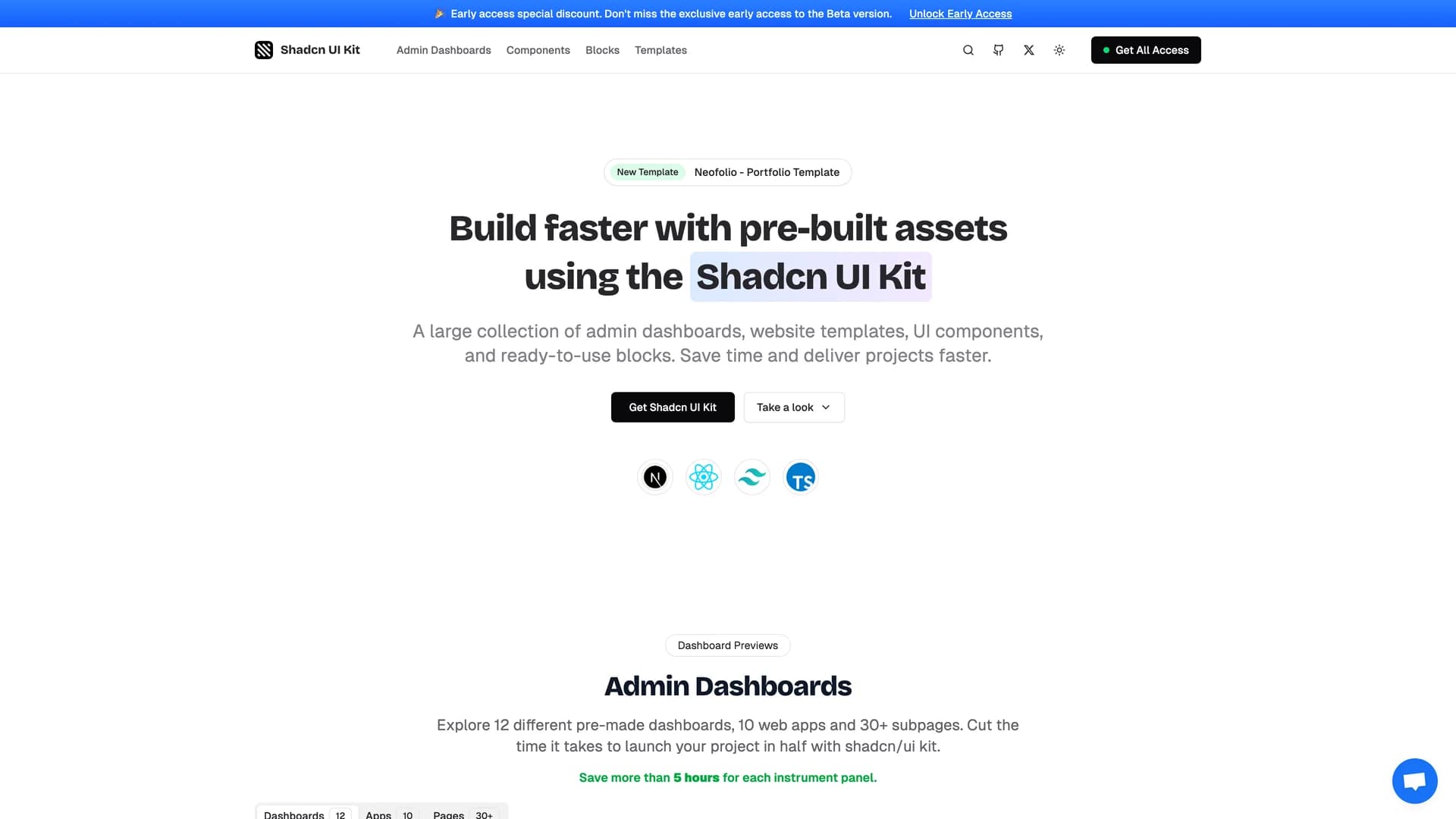
Shadcn Dashboard Free
Shadcn UI Kit is a comprehensive collection of ready-to-use admin dashboards, website templates, and customizable components built with React, TypeScript, Next.js, and Tailwind CSS, offering developers enhanced functionality and design flexibility for modern web applications. This free version provides a preview of the extensive PRO collection, including 1 fully functional dashboard, 5+ pre-built pages, and a single color scheme, giving developers a taste of professional admin interface design without upfront cost. The kit features production-ready dashboard layouts with common admin patterns like sidebars, navigation, and content areas, responsive page templates for user management, settings, analytics, and more, customizable shadcn/ui components following modern design principles, TypeScript throughout ensuring type safety and better developer experience, and Tailwind CSS for rapid styling customization. The PRO version significantly expands capabilities with 10 complete dashboards covering various use cases, 50+ pages for comprehensive admin functionality, 10+ full web applications demonstrating different architectures, 100+ premium components beyond the basic shadcn/ui set, multiple color schemes allowing brand customization, dark and light mode support for user preference, LTR and RTL support for international applications, and extensive theme customization options. Unlike building admin dashboards from scratch or using rigid, dated templates, this UI kit provides modern, flexible components that can be adapted to specific needs while maintaining consistent design language. The free version is perfect for indie developers building side projects who need professional admin interfaces, teams evaluating the kit before purchasing PRO, students learning modern web development with production-quality examples, small businesses creating internal tools with limited budgets, and developers who want to understand shadcn/ui patterns through complete dashboard examples. The kit demonstrates how to structure admin applications, implement common dashboard patterns, create reusable component libraries, and design flexible, themeable interfaces.